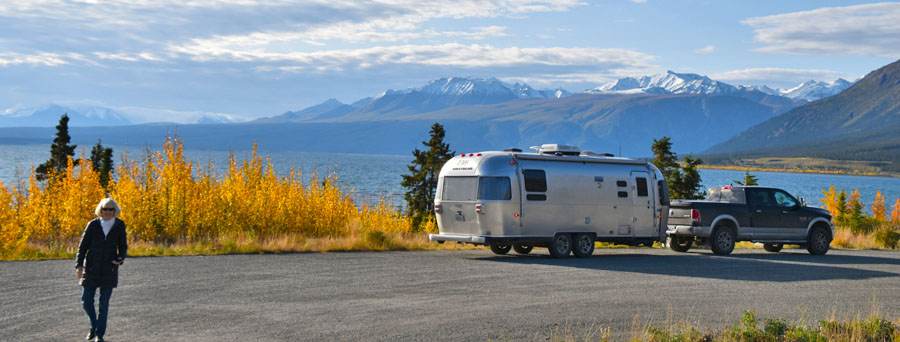
October 2018 - North to Alaska Caravan - part 2
In part 1 we covered the essential travel logistics for a trip north to Alaska. In part 2 we delight in relating the highlights of the caravan. In truth, everyone we traveled with had differing expectations and perspectives, and it’s a full a la carte Alaskan experience, so you can indulge yourself by picking your preferred aspects! Over two months you can see it all!Once the trip was over we checked in with our fellow travelers and asked them to comment on their favorite experiences. Leading responses were glaciers, remote highway travel, boat cruises, private flights, wildlife, tours, and group activities. Collectively there were so many activities in this two-month caravan that the entire trip is the sum of all the parts and provides a package of lasting memories.
As one travels north through British Columbia and Yukon Territory, the first overwhelming impact comes from the massive military operation of 1942 that single-mindedly forged the 1,700 mile ALCAN or Alaska Highway in 18 months, motivated by the desire to connect the US and Alaska because of the fear of a Japanese invasion. The second awareness you absorb is the frenzy and madness of the gold rush that left its mark with human suffering, transformation of the land, and the ingenuity to overcome weather and terrain to extract gold using the latest technology of the times. The third element is undoubtedly the discovery of black gold at Prudhoe Bay and the building of the trans Alaska pipeline. The history of Alaska is defined by the multiple gold rushes, WWII and Cold War militarization of the region, and the oil boom of the 70’s.
Although the Alaska Highway is paved the whole way, the adventure begins when you choose to deviate into the wilderness. At Whitehorse, Yukon, we took the Klondike Highway to Dawson City, Yukon. Then by small ferry, two Airstreams at a time across the Yukon River, we embarked on an unforgettable trek north on the Top of the World highway to Chicken, Alaska. This was a gravel and beaten dirt highway more reminiscent of the original Alaska Highway because it survives the -40°F winter temperatures and permafrost better than paved highways. Caribou herds wandered on and off the highway with little attention to the 35 Airstreams traveling some distance apart to avoid trailing dust. Crossing into Alaska at the US border post in this vast wilderness did not make any difference to the feeling of remoteness as we headed into Chicken, and on a side trip to Eagle where the road north comes to an abrupt and emphatic end.
Over the two-month itinerary many pre-planned activities were included in the caravan. Train rides from Whitehorse to Skagway paralleling the daunting Chilkoot trail of the gold rush stampede and from Anchorage to Whittier through the glacier valleys and mountains, cruises from Haines to Juneau, and from Whittier, Seward and Valdez to the Prince William Sound, stern drive paddle steamers in Fairbanks and Dawson City. One caravan tradition had us all posting our personalized signs in the Watson Lake sign forest along with some other 80,000 other signs. Hot springs in Liard and Chennai enticed us, along with numerous museums covering all aspects of history, technology, ecology, and lifestyle in all the major cities we passed through. Particularly impressive were the huge gold dredges that excavated their way relentlessly up ore rich stream beds for as long as 20 years moving upstream in their own self created lakes, at a speed of one mile a year and a return on investment that paid for itself in the first year! Gold panning in Chicken and in Fairbanks got us excited, and numerous special themed banquets and dinners kept us all very close and connected to the Alaskan experience.
However, many folks were seekers of wider one-time life experiences and used free time to make spectacular excursions: private flight beyond the Arctic Circle, some to the Arctic Ocean, bear watching trips to inaccessible national parks, unique photographic locations, historical pioneer remote retreats, and flights by helicopter or ski equipped aircraft to land on glaciers impossible to reach by land or foot. It was noted that 1 in 70 Alaskans has a private pilot’s license and judging by the number of float planes at lake front homes one realizes that is the only logical way to get around!
From day one through to the last day, the underlying joy of the caravan was the wildlife! The excitement was shared over CB channel 14 as bears, moose, elk or herds of caribou were spotted and locations relayed to fellow travelers. One activity took us to the legendary Iditarod kennels where we enjoyed a sled-on-wheels ride towed by a team of 14 sled dogs, learned about the history of the iconic race, and met the breeders. The most heartbreaking experience was watching the salmon life cycle as they return to their breeding grounds to spawn in the river gravel and then die. A cruise from Homer to Seldovia took us close up to puffin, murres, cormorant and eagle colonies, sea lions and otters, and returned to port via a whale breeching display. Grizzly and black bear were spotted many days of the journey and provided an unforgettable experience at the Chilkoot River weir in Haines as families of bears and cubs crossed the road to playfully fish in the river and enjoy a feast of fresh salmon.
Over 63 days (27 in Canada, 36 in Alaska) we camped at 26 locations and enjoyed some outstanding scenic drives. Along with the previously mentioned Top of the World Highway, the Denali George Parks Highway offered rare clear glimpses of the impressive Mt. Denali peak cresting at over 20,000 ft. The highway from Valdez to Haines circumnavigated the virtually inaccessible Wrangell-St Elias National Park mountain range (larger than the size of Switzerland) for three days and offered us magnificent views from three cardinal viewpoints that changed each day. The return south via the Cassiar Highway was a three-day steady improvement in road conditions and a constant reminder of the sheer beauty of the wilderness, especially with the fall leaf color change in full progress.
It must be noted that Alaska has more than its fair share of National Parks and much more NP land coverage than the lower 48. The irony is that most of the parks are not accessible unless you hike in or travel by seaplane or boat. In the winter, snowmobiles, dog sleds, or planes fitted with skis are additional options. Huge areas such as Gates to the Arctic, Yukon-Charley Rivers, Lake Clark, Katmai and Wrangell-St Elias stay pristine for a very good reason!
Culinary tastes were also satisfied with lots of salmon fishing and tasting. We learned about the five Alaskan salmon species, King or Chinook being the prime delight. Several took advantage of the very special halibut fishing trips, and their success inspired a caravan fish fry. Many folks experienced the unique fishing opportunities in the Kenai Peninsula where local boats were loaded in the parking area with fishermen and tractor-trailered down a ramp into the Cook Inlet and recovered hours later with their bountiful catch. Reindeer, elk and bison were popular meat and sausage indulgences along with fresh delights of Alaskan king crab, Bering Sea colossal crab legs and Kachemak Bay oysters. For the sweet tooth travelers, additional pounds on the waistline can be attributed to the abundant and gigantic iced cinnamon buns that irresistibly and addictively awaited us at each café, restaurant, diner or fuel stop along the highway.
Along the journey, we were reminded of the fate that befell the First Nation Indian tribes that lived here for centuries. The impact of building the highway right through their lands, the exposure to new diseases, the strife caused by zealous religious conversion, and the ultimate loss of the fur trade decimated their culture and community. One particularly moving story is told in the video and displays of the George Johnston Museum. Johnston was a Tlingit photographer who captured both the lifestyle and the heartbreak of his tribe from the early 1900’s to contemporary life.
Glaciers, glaciers and more glaciers! Alaska is full of them - over 600 named - even though they are all retreating! We visited them by road, by hiking, by ski plane to the Helena glacier under Mt. Denali, by helicopter in Wrangell and by cruise boat in Prince William Sound from Whittier to the sheltered Blackstone Bay. From Valdez, a catamaran cruised through miles of ice field and ice floes to watch icebergs separating from the Columbia glacier. As we approached the final few days of the trek many took advantage of slipping across the border from Stewart BC back to Hyder, Alaska and driving up the rough road overlooking the huge two pronged, impressive and accessible Salmon glacier.
It would be naïve to think that this journey could be completed without some pain. After all, to nearly 5,000 miles of Airstream towing, add an average of 3,000 miles to and from home base, plus another 2,000 miles of local touring in your truck – that’s 10,000 miles and all 35 Airstreams made it back! In the worst-case scenario, one of the leaders had to replace his truck! Other casualties included, dozens of flat tires and serious punctures, shattered Airstream and truck windows, leaking water tanks, leaking roof, trailer brake seizure, hitch separation failure, power cable breakdown, electrical melt downs, fridge and furnace failure, and many shower doors that fell off or went trapezoidal. Probably the most annoying aspect was the ingress of dust and dirt into the Airstream, especially if you accidentally left your vent open under way. The redeeming aspect was the huge knowledge, support and hands-on help getting problems resolved. It was amazing the multitude of spare parts that 35 Airstreamers collectively carry on a caravan!
In the final reality, a two-month trek through Alaska and Canada is an overwhelming dose of experiences, with the likelihood of great activities or sights being eclipsed by the avalanche of even more stunning experiences as you head down the road. How do you process it all? With great difficulty!
Our thanks for organizing this ultimate North American caravan goes to both our co-leaders and their wives who spent so much preparation time and poured their life experiences into fine-tuning this trip for the 67 other very fortunate travelers. One asks why do they become caravan leaders with the attendant significant unreimbursed costs and heavy time demand? Their answer was emphatic: for the sheer pleasure of helping fellow Airstreamers enjoy the wonderful gift of Alaskan adventure travel!
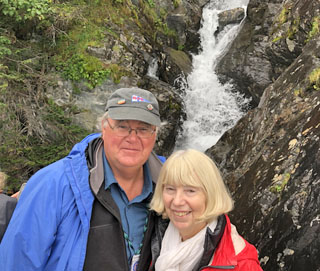 Margaret & David Broad (WBCCI #2381) from Tappahannock Virginia, traveling 8 months of the year since July 2016 in their 2015 Flying Cloud 25 RB. Their travel blog is at www.flyingcloud25.blogspot.com and David also publishes an Airstream improvement discussion at www.facebook.com/airstreamtweaks
Margaret & David Broad (WBCCI #2381) from Tappahannock Virginia, traveling 8 months of the year since July 2016 in their 2015 Flying Cloud 25 RB. Their travel blog is at www.flyingcloud25.blogspot.com and David also publishes an Airstream improvement discussion at www.facebook.com/airstreamtweaks
Excursions part of the WBCCI Alaska caravan- taking a catamaran cruise from Whittier, Alaska and exploring the coastline of Blackstone Bay on the Prince William Sound. We cruised up to two tidewater glaciers - Blackstone and Beloit - and five alpine glaciers. The captain takes you up close to the calving ice wall and the trip is narrated by a Chugach National Forest Service Ranger.
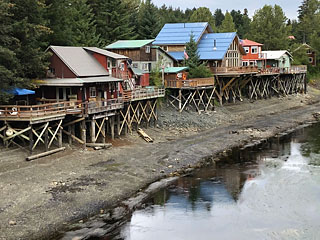 |
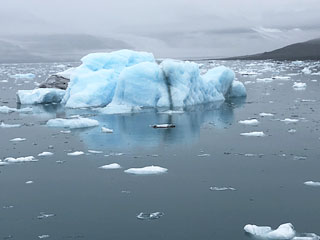 |
|
|
Seldovia in the Kenai peninsula on Kachemak Bay prospered in the 1800's. Originally established as a Russian fur trading post, it became a waypoint for the Goldrush. Only accessible by air or boat it was devastated by an earthquake in 1964 and slowly the waterfront has been rebuilt. |
On a catamaran cruise out of Valdez the captain takes us up the Prince William Sound towards the Columbia glacier. As we get closer larger and larger icebergs calved off the glacier become so numerous he has to turn back. |
|
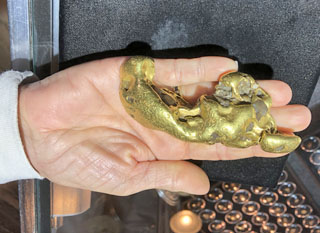 |
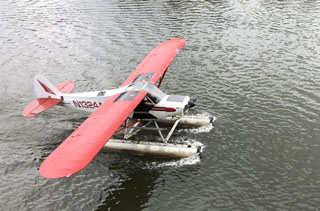 |
|
| The goldrush stampede in Fairbanks was very profitable for a few lucky prospectors. This nugget - one of the largest found - is worth $75,000. At this location, Dredge #8 worked a river bed for 4.5 miles and produced 7.5 million ounces of gold. |
A bush floatplane is demonstrated for us in Fairbanks as we cruise down the Tanana River. The pilot agilely takes off and lands while talking to us by two way radio. This is a 1951 Piper which in winter time is converted to skis instead of floats. |
|
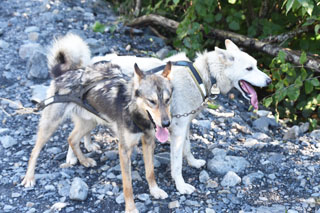 |
|
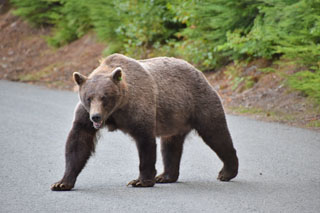 |
| The Iditarod center in Seward gives you a dog sled experience - on wheels rather than on snow. Fourteen sled dogs are hitched up for a tour around the forest. These dogs are bred for endurance and are a mixed genetic heritage derived from Siberian Husky, Chinook, Samoyed, Border Collie, Alaskan Malamute and several other breeds. |
Grizzly and black bear were spotted many days of the journey and provided an unforgettable experience such as at the Chilkoot River weir in Haines as families of bears and cubs crossed the road to playfully fish in the river and enjoy a feast of fresh salmon. |
|
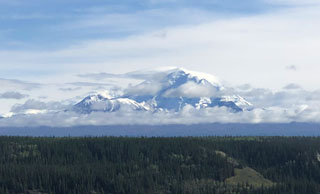 |
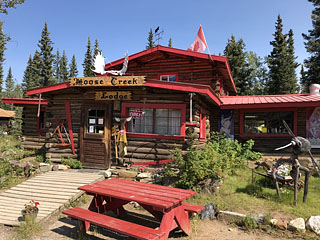 |
|
| The highway from Valdez to Haines circumnavigated the virtually inaccessible Wrangell-St Elias National Park mountain range (larger than the size of Switzerland) for three days and offered us magnificent views from three cardinal viewpoints that changed each day. |
Every hundred miles or so there was a cafe or lodge to stop and grab a bite, some more elegant than others. Basic fare usually with a vast selection of cake, cookies and huge iced cinnamon buns. |
|
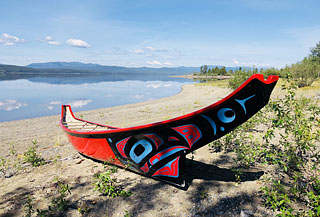 |
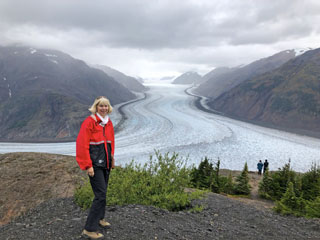 |
|
| The Tlingit first nation natives had their ancestral lands and culture threatened many times including trader and hunter encroachment, gold prospectors, missionaries, military highway builders, disease and loss of the fur trade. |
North of Hyder Alaska lies the magnificent Salmon glacier, accessible by road about 16 miles from Stewart BC. An ice dam breaks every summer and releases a lake under the glacier and floods the valley for a few days. |
|
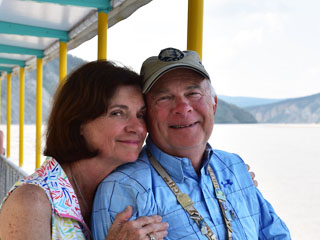 |
|
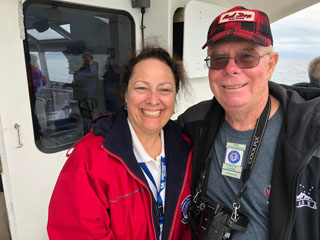 |
| Caravan co-leaders John and Cissy Thibadeau. |
Caravan co-leaders Karl and Cindy Weisenberger. |